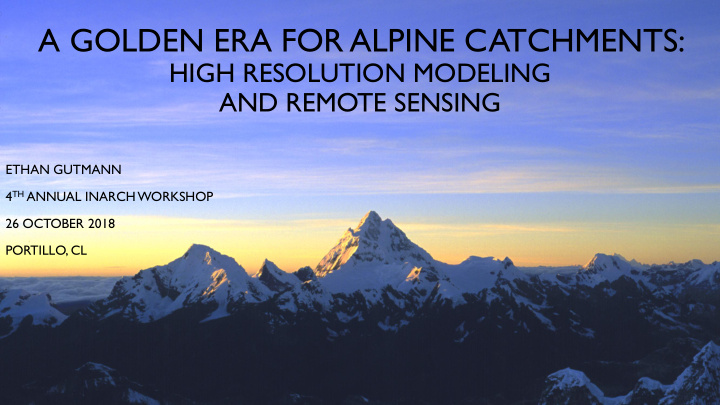



A GOLDEN ERA FOR ALPINE CATCHMENTS: HIGH RESOLUTION MODELING AND REMOTE SENSING ETHAN GUTMANN 4 TH ANNUAL INARCH WORKSHOP 26 OCTOBER 2018 PORTILLO, CL
THE MAKING MEASUREMENTS IN ALPINE TERRAIN IS PROBLEM DIFFICULT
The problem now is making optimal use of the tools and data we have • Tremendous advances in remote sensing A DIFFERENT • ASO, InSAR, cubesats, and the growing legacy of landsat, etc. PROBLEM • Tremendous advances in hydrology and atmospheric modeling • Long term convection permitting modeling • LES modeling over catchments • MESH, WRF-hydro, etc.
REMOTE SENSING • ASO provides snow (and forest) measurements we never thought possible 20 years ago • Cubesats provide unprecedented image frequency • Thermal Imagery provides a long history of land geophysical measurements
REMOTE SENSING: ASO / LIDAR • Snow depth maps provide basin totals • Also reveal process scale information • Snow deposition on lee slopes • Snow ablation from south facing slopes • Snow scouring on windward slopes • Effects of individual trees!
REMOTE SENSING: ANOTHER PATH • Use of high-resolution satellite stereo pairs to map snow depth • Stereo2SWE (Shean et al) • Simultaneously: Gascoin et al • Lower accuracy (10s cm) • Space based (global potential) • Arctic DEM • UAV applications Digital Globe Archive ca 2017
REMOTE SENSING: OPTIMAL USAGE • Snow depth maps quantify basin totals • Perhaps more accurately than “calibrated” hydrology models can use • “Calibrated” models may compensate snow and soil/groundwater storage • When confronted with better snow data this can cause failures • We should do better than uncalibrated models, purely statistical forecasts, or inconsistently calibrated models
REMOTE SENSING: SNOW COVER • Snow covered area • Used to constrain hydrology (and atmospheric) models • Historical: • 500m daily (MODIS) • 30m ~monthly (LANDSAT) • Now: • ~3m “daily” (Planet)
REMOTE SENSING: VEGETATION • LiDAR (and stereo) derived canopy height / volume • Snow interception • “not very remote” sensing • Videos of tree sway can measure interception
REMOTE SENSING: THERMAL DATA • An untapped data source • Difficult to work with • Sensitive to many factors • Long time series of 60 m (Landsat) to 1 km (MODIS) imagery • Directly related to surface energy balance Gutmann and Small (2010) • Rn + ET + H + G
MODELING • Long-term convection permitting modelling • Intermediate Complexity Models for Alpine Research • Large eddy simulation (snow drift permitting) scale • MESH / WRF-hydro and the rise of hyper- resolution • Are models “better” than observations?
CHANGES IN HURRICANES IN A WARMER CLIMATE Hurricane Ivan (Future climate) Hurricane Ivan (2005) (Pseudo Global Warming approach, Current climate warmer and moister) • Convection Permitting 13 year CONUS domain simulation (current and future climate) • >30 named hurricanes in current climate and same hurricanes in warmer and moister climate • Increases in maximum wind speed • Large increases in maximum precipitation rates (> 50%) • Substantial variability in change signal in different hurricanes Water Vapor (Blues) Precipitation (Green to Red) Changes in Hurricanes from a 13 Year Convection Permitting Pseudo-Global Warming Simulation , Gutmann et al. 2018, (Accepted in Journal of Climate) Corresponding Author: Ethan Gutmann, gutmann@ucar.edu Analysis funded by Det Norske Veritas (DNV) and CONUS simulation by NSF under NCAR Water System Program
WRF CONUS • Are models better than observations? • For precipitation… in the mountains… where we don’t have observations • Liu et al (2016), Lundquist et al (2016, 2019), Gutmann et al (2012) “ Obs ” x
MODELING: INTERMEDIATE COMPLEXITY ATMOSPHERIC MODEL
MODELING: SNOW DRIFT RESOLVING LES • Large eddy simulation (LES) Snow Depth [m] • snow drift permitting scales • Are models “better” than observations? • For wind… where we don’t have observations (everywhere) Vionnet et al (2017)
BRINGING THEM TOGETHER • How can remote sensing improve modeling? • Holding the model’s feet to the fire • How can modeling improve remote sensing? • “better than obs ” supporting data • How can both be combined to improve alpine hydrology • Model-data fusion to produce better forcing dataset • Data for parameter estimation
MODEL – DATA FUSION • Snow covered area to constrain precipitation occurrence and phase • GPM precipitation radar and cloud top further constraints • Skin temperature measurements provide air-temperature covariate • Using observed and modeled precipitation • Climatological obs or climatological model • Model spatial covariance or obs • … other possibilities
NEXT GENERATION CATCHMENT MODELS • Hyper-resolution solves some problems, introduces others • Resolve slope, aspect, elevation, vegetation covariance • Hyper-resolution means hyper-parameter • Hyper-resolution forcing requirements • Hyper-resolution data for comparisons • Snow (and streamflow) provides an observable that integrates many relevant processes • Needs hyper-resolution forcing
THE REVOLUTION IN MODELS AND REMOTE SENSING • New (and older underutilized) remote sensing datasets provide insight to Alpine Catchment processes • ASO / Lidar, Stereo, UAVs, thermal data, GPM, … • New atmospheric models are exceeding the skill of our “observations” • Precipitation, wind, …short wave? Longwave? • Can provide excellent forcing for hydrologic models with caveats (chaos) • The next major advance will be learning how to make better use of both of these datasets and combining them with existing station data
Questions?
Recommend
More recommend